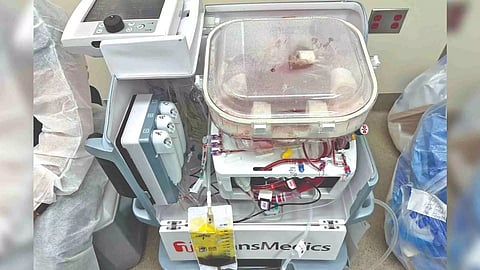

CHENNAI: On some level, the human liver in the operating room at Northwestern Memorial Hospital in Chicago was alive. Blood circulating through its tissues delivered oxygen and removed waste products, and the organ produced bile and proteins essential to the body.
But the donor had died a day earlier, and the liver lay inside a boxy plastic device. The organ owed its vitality to this machine, which was preserving it for transplantation into a needy patient.
“It’s a little bit science fiction,” said Dr Daniel Borja-Cacho, a transplant surgeon at the hospital.
Perfusion, as it’s called, is changing every aspect of the organ transplant process, from the way surgeons operate, to the types of patients who can donate organs, to the outcomes for recipients.
Since 2020, Northwestern has had a 30% uptick in its volume of liver transplants. Nationally, the number of lung, liver and heart transplants each rose by more than 10% in 2023, one of the largest year-over-year increases in decades.
Why perfusion?
Without blood flow, organs rapidly deteriorate. That’s why clinicians have long considered the ideal organ donor to be brain dead but whose heart continued beating, keeping the organs viable until they could be matched with recipients.
To minimise injury to organs after their removal from a donor’s blood supply and before they are connected to a recipient’s, surgeons used to cool them to just above freezing, significantly slowing their metabolic processes. This extends the window in which organs can be transplanted, but only briefly. Livers remain viable for no longer than 12 hours, and lungs and hearts closer to six.
After years of development, the first device for preserving lungs via perfusion won the FDA approval in 2019. Devices for perfusing hearts and livers were approved in late 2021. The devices essentially pump blood or an oxygenated fluid through tubes into the blood vessels of the donated organ. Because cells in a perfused organ continue to function, clinicians can better assess whether the organ will thrive in a recipient’s body.
Bolstered by that information, transplant surgeons have begun using organs from older or sicker donors that they might otherwise have turned down, said Dr Kris Croome, a professor of surgery, Mayo Clinic in Florida. “We’re going after organs we never would have before, and we’re seeing good outcomes,” he added.
Perfusion also eases the gruelling process of organ recovery and transplant, hours-long surgeries that doctors often conduct against the clock, beginning in the middle of the night and completed in back-to-back succession. Now surgical teams can recover an organ, perfuse it overnight while they sleep and complete the transplant in the morning without fear that the delay would have damaged the organ.
Perhaps most importantly, perfusion has opened the door to organ donation by comatose patients whose families have withdrawn life support, allowing their hearts to eventually stop. Each year, tens of thousands of people die this way, after the cessation of circulation, but they were rarely donor candidates because the dying process deprived their organs of oxygen.
Spike in transplants
Now, surgeons are perfusing these organs, either by removing them to a machine or, in a lower-tech manner, by recirculating blood in that region of the donor’s body. And that has made them much more appealing for transplant.
Since 2020, the number of livers transplanted after the circulatory death of the donor has doubled, according to an analysis of data from the United Network for Organ Sharing, the non-profit that runs the US’s transplant system. Surgeons never used hearts from such donors because of organ’s sensitivity to oxygen deprivation. But in 2023, thanks to perfusion, they transplanted over 600.
By tapping this new cadre of donors, transplant centres said they could find organs more quickly. Dr Shimul Shah, director, organ transplant programme, University of Cincinnati, said, “Perfusion has essentially wiped out our waiting list for livers. I never thought I’d ever say that.”
Expensive tech
One obstacle to the adoption of the technology may be cost. At the rates demanded by device makers, perfusing an organ outside the body can add over $65,000 to the price of a transplant. Smaller hospitals may not be able to justify the expense.
But some surgeons said that the technology might nonetheless save money, since patients who receive perfused organs generally leave the hospital faster and with fewer complications, and have better medium- and long-term outcomes.
Surgeons are still exploring the upper limits of how long perfused organs can survive outside the body, and as the technology continues to evolve transplant surgeries, some say this is only the beginning.